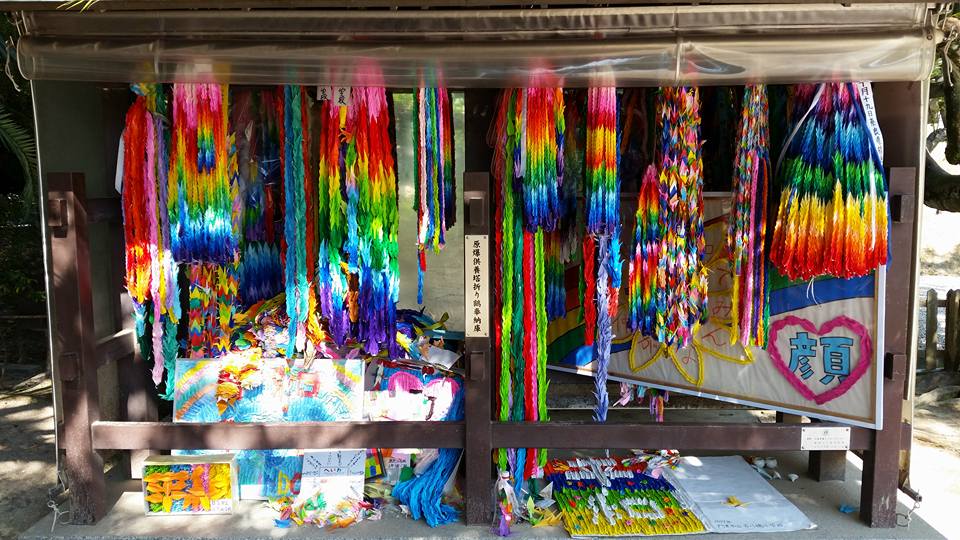By Rev Denise Liersch
It’s 75 years today since an atomic bomb was dropped on Hiroshima, destroying the city and everything in it: children, women and men alike, parks and gardens, wildlife, waterways, landscape and neighbourhoods. Today we remember.
Almost three years ago, I spent a day at Hiroshima’s museum and Peace Park with my family. It was a day more of silence than words, hearing and reading of memories and stories through memorials that tell of the destruction and devastation of war, both immediate and continuing for years after.
There is a museum, which tells these stories. But the whole park is a memorial, telling stories of the suffering that comes when aggression is met by aggression, when violence is met by violence.
At the A-bomb Dome, now a World Heritage Site, we are reminded: “At 8:15 on the morning of August 6, 1945, the first atomic bomb used against humankind exploded about 600 meters above Shima Hospital … utterly destroying all people and property below it. Among the burned ruins stood the skeletal remains of the Hiroshima Prefectural Industrial Promotion Hall (now the A-bomb Dome), a grim reminder of what had been … to remind future generations that this neighbourhood was erased by the atomic blast.”
At the Atomic Bomb Memorial Mound are laid the ashes of tens of thousands of the victims of the bomb – those who died instantly or within hours where they lay, and then gathered for cremation.
At the Memorial Monument to the Children of the Hiroshima Municipal Girls’ School, a sculpture reminds us of 676 school students who died as the bomb exploded above their heads.
And the Children’s Peace Monument reminds us not only of the indiscriminate impact of nuclear weapons on innocent children, but of the ongoing effects on families and communities for years and generations beyond the event.
The monument was originally inspired by the death of Sadako Sasaki, who was exposed to radiation from the atomic bomb at the age of two. Ten years later, Sadako developed leukemia that ultimately ended her life. Her classmates called for a monument for all children who died due to the atomic bomb. Now, multiple groups of schoolchildren visit the monument every day, each singing songs of memory and peace, and laying wreaths of paper cranes in the rainbow colours of hope. The paper cranes are laid on a stone inscribed thus: “This is our cry. This is our prayer. For building peace in this world.” Their song ends with the ringing of the monument’s bell, which is inscribed with the words: “Peace on the Earth and the Heavens.” The paper cranes and the children’s messages are displayed in cabinets for all to see and hear their prayers.

Paper cranes with the prayers and messages of children. Photo by Denise Liersch
On the day I was there with my family, the visitors were overwhelmingly Japanese, although there was also a sprinkling of overseas visitors. The more distant we are from the epicentre of disaster or war, the easier it is to forget. How easy it is for us to forget, to lose touch with the reality of the impact of seeing acts of aggression as a response to acts of aggression, as we are distanced by space, geography or time.
We are not just talking about international war, but human conflict and disagreement of any kind. How quickly we tire from the long hard work of working for peaceful resolution, and decide it’s time to resort to “the nuclear option”: responding to conflict with threats, with our finger hovering over the nuclear button – metaphorically speaking.
We say so often that peace is not simply the absence of war. Likewise, peace is not something that just happens. We make peace, we build peace, we negotiate and compromise and work for peace. We resist the temptation to simply roll over and allow the aggression of others. We resist the temptation to respond with like for like, meeting aggression with more aggression.
Today, on this anniversary we won’t be solving the conflicts of the world, but we do remember why it matters.
At the Bell of Peace monument in the Hiroshima Peace Park are these words:
We dedicate this bell
as a symbol of Hiroshima Aspiration:
Let all nuclear arms and wars be gone,
and the nations live in true peace!
May it ring to all corners of the earth
To meet the ear of every man,
for in it throb and palpitate
the hearts of its peace-loving donors.
So may you, too, friends, step forward, and toll this bell for peace!

